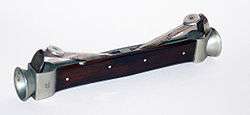Cigar cutter
A cigar cutter is a mechanical device designed to cut one end off a cigar so that it may be properly smoked. Although some cigars are cut on both ends, or twirled at both ends, the vast majority come with one straight cut end and one end in a "cap" which must be cut off for the cigar to be smoked. Most quality handmade cigars, regardless of shape, will have a cap which is one or more small pieces of a wrapper pasted onto one end of the cigar with either a natural tobacco paste or with a mixture of flour and water. The cap end of a cigar is the rounded end without the tobacco exposed, and this is the end one should always cut. The cap may be cut with a knife or bitten off, but if the cap is cut jaggedly or without care, the end of the cigar will not burn evenly and smokeable tobacco will be lost.
Types

There are three basic types of cigar cutters:
- Guillotine (straight cut)
- Punch cut
- V-cut (a.k.a. notch cut, cat's eye, wedge cut, English cut)
Straight cut
The straight cut is the most common, usually used on cigars with a smaller ring gauge. This cut uses a quick straight cut causing both ends of the cigar to be exposed. The double blade guillotine is preferred by many aficionados over the single blade, because it usually makes a cleaner cut. Cigar scissors are also used to make straight cuts, and may be the best choice for cutting the cigar with exactness. However, the guillotines are usually the most practical, the least expensive, and can be easily and safely carried in shirt or trouser pockets. Most prefer this cut because the entire cap end is exposed allowing for maximum smoke to exit with only minimum buildup occurring around the edge.
Punch cut
There are three basic types of cigar punches, a bullet punch, Havana punch, and multi-punch. The bullet punch is a bullet shaped device that fits on a keychain. The punch can be twisted to expose a circular blade, used to cut a hole in the cigar cap. This cut is preferred by some, as it exposes less of the filler and binder and reduces the chance of tobacco ending up in the mouth. Critics of this cut maintain that the smaller hole does not allow as much smoke to come out and the hole is often clogged with a saliva and tobacco buildup. One problem associated with these otherwise handy, durable and inexpensive devices is that the unscrewable top is easy to lose, leaving the blade exposed in the user's pocket. "Havana punches" offer some of the same convenience but with more safety. Rather than an easy-to-lose top, the blade is recessed and springs out at the push of a button. Multi-punches offer different-sized punch holes for different sizes of cigars.
V-cut

The last of the most common type of cuts is the V-cut. V-cutters look like guillotine cutters, but cut a wedge into the cigar cap rather than completely removing it, creating a clean-looking gash. Good V-cutters penetrate deeper into the filler than straight cutters, and some smokers prefer them for thicker gauge cigars. However, cheap V-cutters can result in sloppy cuts too deep into the cigar, which result in an uneven burn.
History
Frederick William Fairholt, in 1859, describes an early cigar cutter as follows:
In Berlin, a few years ago, an ingenious pocket- knife, entirely of steel, was fabricated for the use of cigar-smokers, of which we here give an engraving.
It had all the strength of the usual knife, but the spring was so constructed that it did not shut down to the edge of the blade; the cigar-end being placed through the aperture at the end, the point of the knife, on being pressed down by the finger, cut off the end of the cigar.[2]
Fairholt also describes another device:
Another simple little implement, to act as cigar-cutter and holder... The double cutter at one side takes off the end of the cigar, and, when closed, acts as a hold for the finger and thumb, the opposite arms closing round the cigar and securing it very firmly. A small loop on one of the cutters allows it to be attached to the watch-chain if desired.[1]
Danger of injury
It is possible to receive a severe injury from a poorly handled cigar cutter. In 1999, basketball star Michael Jordan injured a finger with a cigar cutter which some believe led to his second retirement.[3][4]
See also
References
- 1 2 Frederick William Fairholt, Tobacco: Its History and Associations (1859), p. 224.
- ↑ Frederick William Fairholt, Tobacco: Its History and Associations (1859), p. 223.
- ↑ http://sportsillustrated.cnn.com/basketball/nba/news/2000/03/22/jordan_finger_ap/
- ↑ Elliott Harris, "Fickle finger of fate: MJ clumsy with cigar", Chicago Sun-Times, (January 14, 1999), Sports, pg. 109.
External links
| Wikimedia Commons has media related to Cigar cutters. |
| Look up cigar cutter in Wiktionary, the free dictionary. |